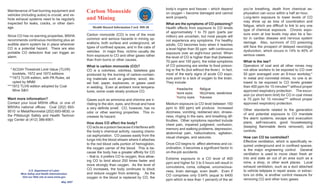
Carbon Monoxide and Mining industrialguidelines.pdf
- 1. Carbon Monoxide and Mining Health Hazard Information Card HH-28 Carbon monoxide (CO) is one of the most common and serious hazards in mining op- erations, both surface and underground, all types of confined spaces, and in the cabs of vehicles. In major fires, victims usually die from exposure to CO and other gases rather than from burns or other causes. What is carbon monoxide (CO)? CO is a colorless, odorless, tasteless gas produced by the burning of carbon-contain- ing materials such as gasoline, wood, die- sel fuel, paper, explosives, or gases used in welding. Even at ambient mine tempera- tures, some coals slowly produce CO. Gases such as ammonia and chlorine are ir- ritating to the skin, eyes, and throat and have a very definite smell. CO, however, has no odor or other warning properties. This in- creases its hazard. How does CO affect the body? CO acts as a poison because it interferes with the body’s chemical activity, causing chemi- cal asphyxiation. CO passes easily from the lungs into the blood stream where it attaches to the red blood cells portion of hemoglobin, the oxygen carrier of the blood. This is be- cause the body has a greater affinity for CO – that is, it prefers CO to oxygen, thus allow- ing CO to bind about 250 times faster and more strongly than oxygen. As the level of CO increases, the body continues to block and reduce oxygen from entering. As the oxygen in the blood is replaced by CO, the body’s organs and tissues – which depend on oxygen – become damaged and cannot work properly. What are the symptoms of CO poisoning? Health effects from exposure to CO levels of approximately 1 to 70 ppm (parts per million) are uncertain, but most people will not experience any symptoms. For healthy adults, CO becomes toxic when it reaches a level higher than 50 ppm with continuous exposure over an eight-hour period. When the level of CO is higher than that (between 70 ppm and 100 ppm), the initial symptoms of CO poisoning are similar to food poison- ing or the flu (but without the fever). In fact, most of the early signs of acute CO expo- sure point to a lack of oxygen to the brain. They include: »headache » fatigue »sore eyes » dizziness, weakness »runny eyes » nausea Medium exposure (a CO level between 150 ppm to 300 ppm) will produce increased dizziness, vomiting, reddened skin, drowsi- ness, ringing in the ears, and breathing dif- ficulties. Other symptoms reported include chest pain, impaired judgment, confusion, memory and walking problems, depression, abdominal pain, hallucinations, agitation, visual changes, and seizures. Once CO begins to affect alertness and co- ordination, it becomes a significant factor in on-the-job accidents. Extreme exposure to a CO level of 400 ppm and higher for 3 to 5 hours will result in convulsions, coma, collapse, unconscious- ness, brain damage, even death. Even if CO comprises only 0.64% (equal to 6400 ppm which is less than 1 percent) of the air you’re breathing, death from chemical as- phyxiation can occur within a half an hour. Long-term exposure to lower levels of CO may show up as loss of coordination and fatigue, which are difficult to link to any one type of chemical exposure. Chronic expo- sure even at low levels may also be a fac- tor in cardiac disease and nervous system damage. Also, survivors of CO poisoning still face the prospect of delayed neurologic dysfunction, which occurs in 14% to 40% of serious cases. What is the law? Operators of coal and all other mines may not allow workers to be exposed to CO over 50 ppm averaged over an 8-hour workday.* In metal and nonmetal mines, no one is al- lowed to be exposed to CO levels greater than 400 ppm for 15 minutes** without proper approved respiratory protection. The excur- sion (or short-term limit) for CO in coal mines is 75 ppm for 15 minutes*** without proper approved respiratory protection. Other standards related to the generation of and potential exposure to CO mandate fire alarm systems, escape and evacuation plans, self-rescuers, good housekeeping (keeping flammable items removed), and controls. How can CO be controlled? Effective ventilation, which is specifically re- quired underground and in confined spaces, is the major engineering control. General ventilation is used to move clean fresh air into and stale air out of an area such as a mine, a shop, or other work places. Local exhaust ventilation, such as a duct attached to vehicle tailpipes in repair areas, or extrac- tors on drills, is another control measure for removing CO and other toxic gases. Maintenance of fuel-burning equipment and vehicles (including autos) is crucial, and ve- hicle exhaust systems need to be regularly inspected for leaks, cracks, or other dam- age. Since CO has no warning properties, MSHA recommends continuous monitoring plus an audible alarm system be in place wherever CO is a potential hazard. There are also portable CO detectors that can trigger an alarm. _______________________ * ACGIH Threshold Limit Value (TLV®) booklets, 1972 and 1973 editions **1973 TLV® edition, with PA Rules, ad opted by MNM ***1972 TLV® edition adopted by Coal Mine S&H Want more information? Contact your local MSHA office, or one of MSHA’s national offices: Coal (202) 693- 9510 or Metal/Nonmetal (202) 693-9630; or the Pittsburgh Safety and Health Technol- ogy Center at (412) 386-6901. U.S. Department of Labor Mine Safety and Health Administration Visit our Web site at www.msha.gov May 2007